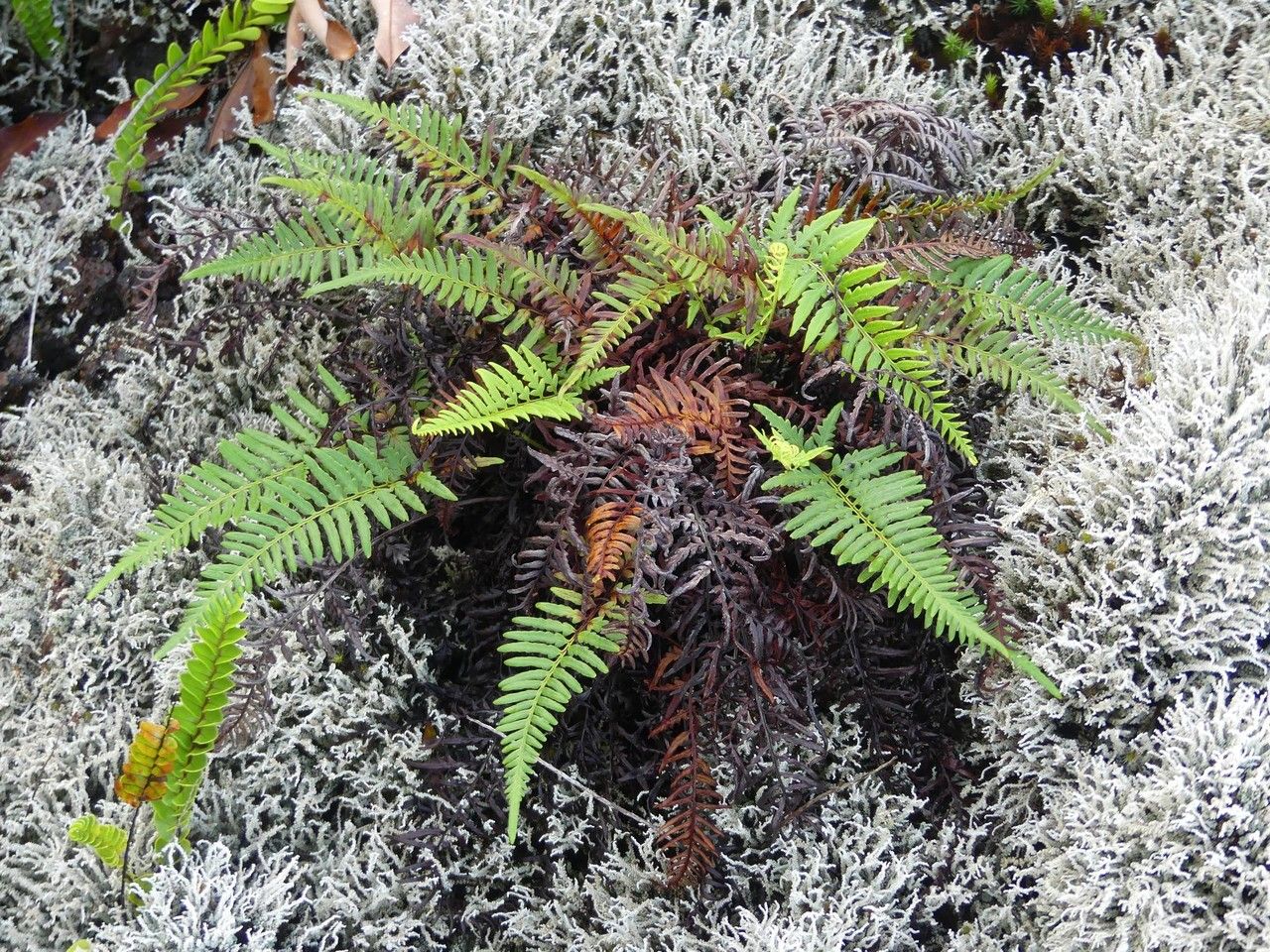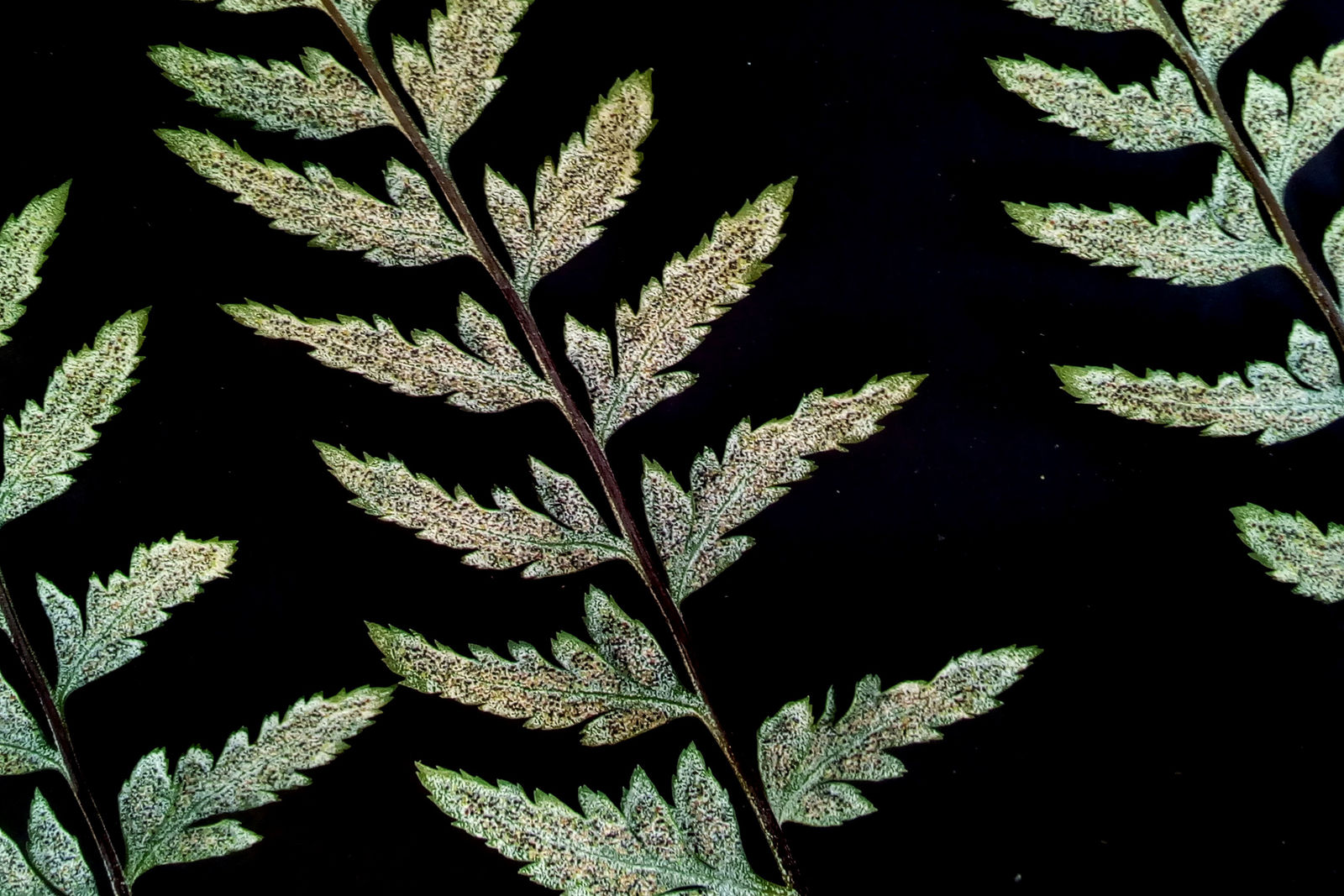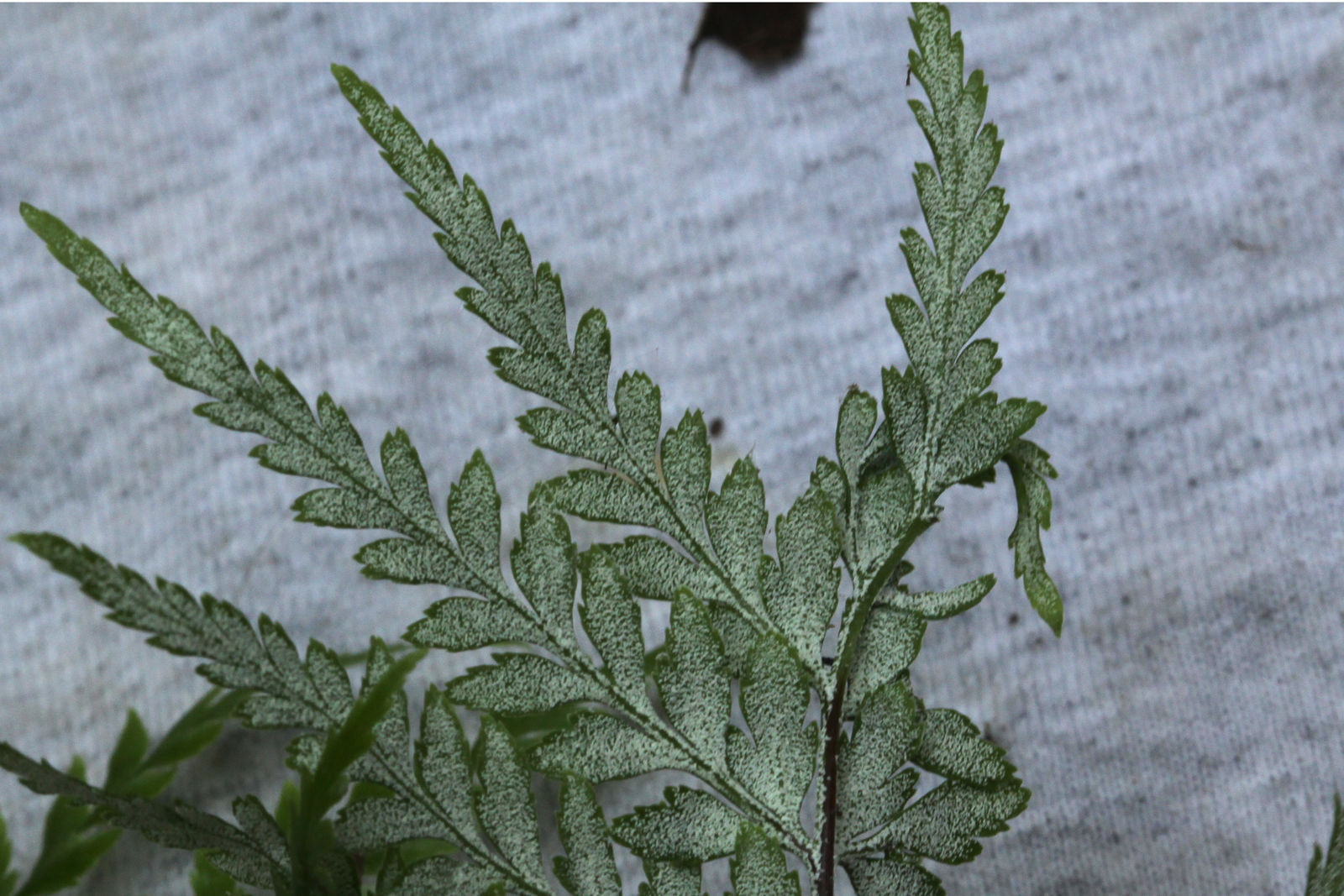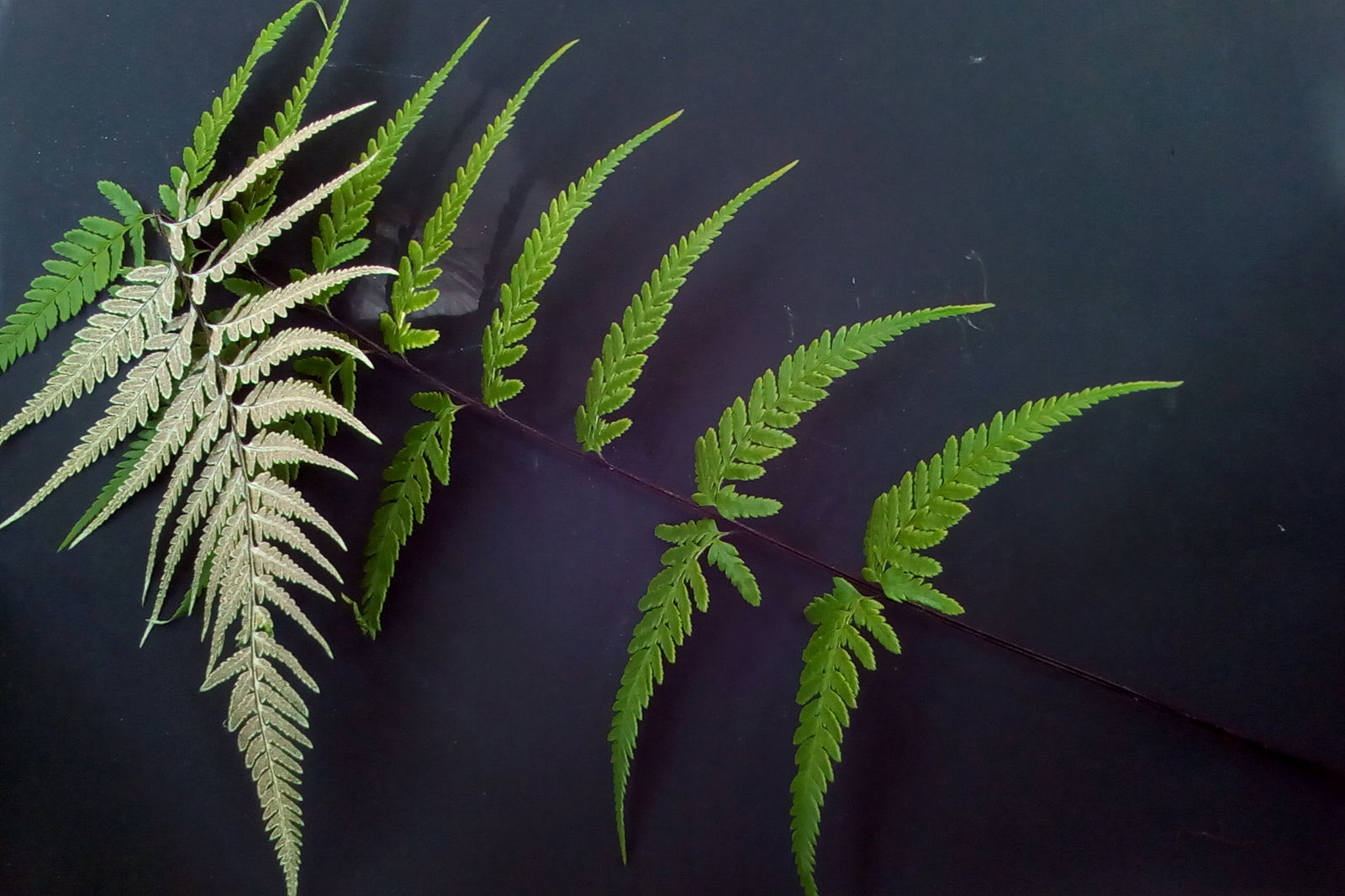Silver Shield Fern, False Goldenweed
pityrogramma calomelanos
Also known as: ["Silverback Fern","Golden Pteris"]
Overview
A delicate, deciduous fern with silvery-white undersides to its fronds, native to tropical and subtropical regions.
Benefits & Perks
["shade tolerant","aesthetic foliage","wildlife attractant (bees, butterflies, birds)"]
Botanical Classification
| Phylum: | Tracheophyta |
| Class: | Polypodiopsida |
| Order: | Polypodiales |
| Family: | Pteridaceae |
| Genus: | Pityrogramma |
| Botanical Name: | Pityrogramma calomelanos |
Plant Characteristics
Basic Information
- Category: Leaf Plants
- Suitable Location: shaded garden bed or container in a humid environment
- Suitable For:
- Is Weed: No
- Allergenicity: low
Environmental Needs
- Climate: {"temperatureRange":"15–30°C"}
- Hardiness: {"zones":"9–11"}
- Misting: every 2–3 days to maintain moderate humidity
- Drainage: Fast-draining to prevent waterlogging.
- Soil Type: Well-draining, slightly acidic mix; e.g., peat-based with perlite or sand.
Maintenance Level
- Maintenance Level: moderate
- Toughness Level: moderate
- Pruning Frequency: As needed, typically every 6–12 months or when fronds decline.
- Pruning Intensity: Light pruning; remove only dead, yellowing, or broken fronds.
Care Details
Ideal Sunlight Coverage:
Bright indirect light for 6–8 hours daily; avoid direct sunlight to prevent scorching.
Sunlight Tolerance Tips:
Acclimate slowly to new light conditions; keep away from harsh afternoon sun; adjust placement seasonally.
Care Requirements
Care Difficulty
moderatemoderate
Sunlight
partial shade to filtered light
Rotate plant weekly; use sheer curtains for filtered light; avoid south-facing windows in summer.
Watering
every 7–10 days, allowing soil to dry slightly between waterings
Water thoroughly but allow excess to drain; avoid wetting the fronds to prevent fungal issues.
Soil
well-draining, humus-rich soil with some sand or perlite
pH: 5.5–6.5 (slightly acidic).
Ensure pots have drainage holes; avoid heavy clay soils; top-dress with fresh soil annually.
Temperature
Prefers 65–75°F (18–24°C); tolerates 50–85°F (10–29°C) with protection from extremes.
Avoid drafts; maintain stable temperatures; protect from sudden heat/cold spikes.
Fertilizing
every 4–6 weeks during active growth with a balanced liquid fertilizer
Fertilize only when actively growing; flush soil occasionally to prevent salt buildup; avoid overfertilizing.
Propagation
Methods
Spores (most common); division of rhizomes (less common).
Step-by-Step Propagation Guide
- Collect spores.
- Scatter on sterile medium.
- Keep moist and humid.
- Or divide rhizomes.
- Repot immediately.
Best Time: Spring or early summer when the plant is actively growing.
Environment
High humidity (70–90%); warm temperatures (70–80°F/21–27°C); indirect light.
Medium
Spore propagation on sterile, moist sphagnum moss or peat-based mix; division in well-draining soil.
Hormone
Not applicable for spores; division may benefit from rooting hormone.
Timeline
Spores: 1–3 months to germinate; division: 2–4 weeks to establish.
Tools Needed
Spore collection kit, sterile knife, humidity dome, pots, well-draining soil.
Quick Tips
Use a fine sieve for spore distribution; keep propagation area consistently moist; label new plants.
Pruning & Repotting
Pruning Guide
Method
Cut fronds at the base with clean, sharp tools; avoid cutting into healthy tissue.
Pruning Plan
Minimal pruning; focus on removing dead or damaged fronds to maintain appearance and health.
Tools
Pruning shears, sterilizing solution, gloves.
Checklist
Inspect for dead/damaged fronds; sterilize tools; cut cleanly; dispose of clippings.
Repotting Guide
Best Season
Spring, before the main growing season begins.
Pot Size
Choose a pot 1–2 inches larger in diameter than the current one.
Method
Remove plant gently; trim roots if necessary; place in new pot with fresh, well-draining soil; water lightly.
Suggestions
Repot every 2–3 years or when roots fill the pot; beneficial for fresh soil and growth space.
Checklist
Check root bound status; prepare new pot with drainage; handle roots carefully; use fresh soil mix.
Advanced Care Tips
Watering Mastery
Watering Checklist
Check soil moisture; water thoroughly; ensure drainage; adjust for season.
How to Apply Water Properly
Water directly at the root zone until water drains from the bottom; ensure even moisture without saturation.
Watering Schedule Tips
Water when the top inch of soil is dry; reduce frequency in winter to prevent root rot.
Soil Improvement
Add perlite or coarse sand for drainage; incorporate organic matter like peat moss for moisture retention.
Temperature Stress Management
Signs of Temperature Issues
Wilting, yellowing fronds, or stunted growth in response to sudden temperature shifts.
Cold Stress
Slows growth; may cause fronds to turn brown or drop; susceptible to root rot in cold, wet soil.
Solution: Move to a warmer location; insulate pot; avoid overwatering in cool conditions.
Hot Stress
Leaf edges may brown; wilting despite adequate water; reduced vigor in excessive heat.
Solution: Provide shade; increase humidity; water more frequently but avoid waterlogging.
Fertilizing Guide
Fertilizing Checklist
Check growth phase; dilute fertilizer; apply to moist soil; rinse pot periodically.
Fertilizing Method
Use balanced liquid fertilizer diluted to half strength every 4–6 weeks during growing season (spring/summer); cease in fall/winter.
Common Problems & Solutions
Toxicity Warning
Cats
Slightly ToxicCats are also susceptible to thiamine deficiency if they ingest significant quantities of Pityrogramma calomelanos. The thiaminase content can cause severe metabolic and neurological disturbances in cats.
⚠️ Symptoms:
🌿 Toxic Parts:
⚡ Toxic If:
if eaten
Dogs
Slightly ToxicSimilar to humans, dogs may experience thiamine deficiency if they consume large amounts of Pityrogramma calomelanos. The thiaminase enzyme can disrupt thiamine absorption, leading to metabolic and neurological issues.
⚠️ Symptoms:
🌿 Toxic Parts:
⚡ Toxic If:
if eaten
Humans
Slightly ToxicPityrogramma calomelanos contains small amounts of toxic compounds, primarily thiaminase, which can interfere with thiamine (vitamin B1) metabolism when ingested in large quantities. This can lead to metabolic disturbances and neurological effects over time.
⚠️ Symptoms:
🌿 Toxic Parts:
⚡ Toxic If:
if eaten
Frequently Asked Questions
Q: How often should I water Pityrogramma calomelanos?
A: Keep the soil consistently moist but not waterlogged; water when the top inch of soil feels dry.
Q: Does this fern require direct sunlight?
A: No, it prefers partial to full shade and can suffer in direct sunlight.
Q: Is Pityrogramma calomelanos toxic to pets?
A: There is insufficient data on its toxicity to pets; it is best to keep it out of reach of animals.
Quick Reference
| Family: | Pteridaceae |
| Care: | moderate |
| Light: | partial shade to filtered ligh |
| Water: | every 7–10 days, allowing so |
Get Expert Care Tips
Download the Plantious app for personalized care reminders and plant identification!
Google Play App Store








